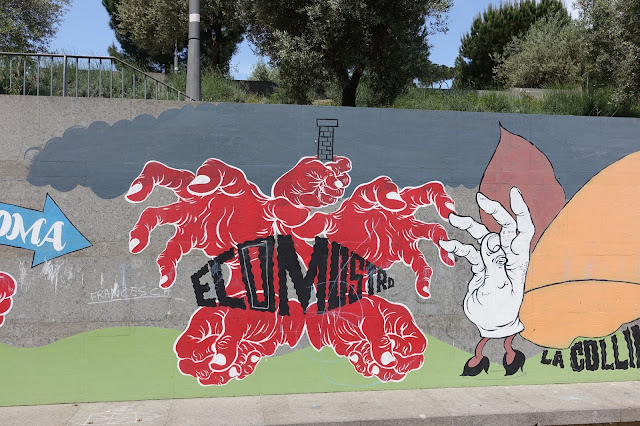Finocchio, a suburb of Rome 18km out the historic via Casilina on the city's east side, has an illustrious ancient history and now, a present worth visiting. Settlement here dates to pre-Roman times--though we're not aware that anything can be seen above ground from that era--and Finocchio is not far from what remains of the pre-Roman community of Gabii. Otherwise, it's much like dozens of other similar towns: apartments, a few shops, a bar where one can buy a drink or a lottery ticket.
Today, what makes the community just a bit unusual is a small park along the main road. Inaugurated in 2007 by then Rome Mayor Walter Veltroni, it's called Collina della Pace (Hill of Peace), a name that refers, with much irony, to its previous owner, mafia boss Enrico Nicoletti, treasurer of the notorious Banda della Magliana gang that brought chaos to Rome in the late 1970s.

As a large wall dedication explains, the park commemorates Giuseppe "Peppino" Impostato, who comes to our story with his own curious history. Peppino himself was born into a mafia family in 1948, yet he took a different course.
 |
Peppino Impostato (right) with Danilo
Dolci, 1967 |
Rather than a life of crime and corruption, Peppino distinguised himself as a poet, a giornalist, and a
peace activist--he participated in a 1967 peace protest organized by social reformer Danilo Dolci (whom we met in Sicily in 1962). In May 1978--during the violent political conflicts of the time known as the
anni di piombo (years of lead), while a candidate in municipal elections, Peppino was assassinated.
 |
Diavù at work
|
Although sometimes described as the only green space in Finocchio, the park is in most ways unexceptional; indeed, one's impression of the park is that it's not even all that green. However, it gains a certain presence from its origins: the land was confiscated from its mafia owner in 2001. Then, in 2014, its main wall was graced by a significant piece of anti-mafia street art, a mural by the well-known artist David Vecchiato (known in the art world as Diavù).

The project was coordinated by M.U.Ro. (Museo di Urban Art di Roma), represented at the end of the mural by the boxed letters M,U,R, and O. We're not sure to what "da Sud" refers.
 |
| Finocchio residents, likely gathered for the mural dedication in 2014 |
While the main themes of the mural--opposition to the mafia, the celebration of peace, and the grasp of capitalism--seem clear enough, elements of it are less so.
Why the reference to "slot-machine"? And what is the meaning of the words "L'antimafia non ha bisogna di eroi" (The anti-mafia has no need of heroes)? Do they refer to the martyrdom of Peppino Impostato? Or to something else? Who is "il biondo di Kosovo" (the blond from Kosovo)?
 |
| "Ecomostro: Pollution as monster, tightening its grip around (a factory chimney?). What's with the white hand--in a skirt, with Minnie Mouse high heels? |
 |
| Walking hands (male figures, apparently), carrying a love Rome sign? Hashtag MAMMAMAFIA? |
Men and women, holding up signs extolling the good things in life: welfare (in English!), home, rights, income, about to be hooked and consumed by the slot machine.
The park is located on the north side of via Casilina, at via Bolognetta. And the mural can be located on, and is explained at, the Street Art Roma app, which we recommend (the app is better than the
Web site).
Bill




No comments:
Post a Comment